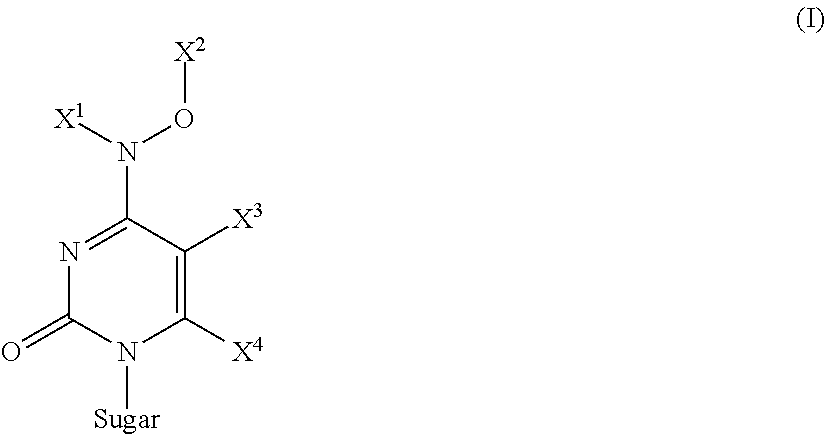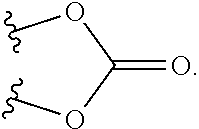Pyrimidine nucleosides and their monophosphate prodrugs for treatment of viral infections and cancer
a technology of monophosphate prodrugs and pyrimidine nucleosides, which is applied in the field of nucleotide analogs, can solve the problems of long time-consuming and laborious cell culture models, significant side effects, and inability to easily adapt to the environmen
- Summary
- Abstract
- Description
- Claims
- Application Information
AI Technical Summary
Benefits of technology
Problems solved by technology
Method used
Image
Examples
specific examples
[0458]Specific compounds which are representative of this invention were prepared as per the following examples and reaction sequences; the examples and the diagrams depicting the reaction sequences are offered by way of illustration, to aid in the understanding of the invention and should not be construed to limit in any way the invention set forth in the claims which follow thereafter. The present compounds can also be used as intermediates in subsequent examples to produce additional compounds of the present invention. No attempt has necessarily been made to optimize the yields obtained in any of the reactions. One skilled in the art would know how to increase such yields through routine variations in reaction times, temperatures, solvents and / or reagents.
[0459]Anhydrous solvents were purchased from Aldrich Chemical Company, Inc. (Milwaukee). Reagents were purchased from commercial sources. Unless noted otherwise, the materials used in the examples were obtained from readily avai...
example 1
[0460]
1-((2R,3R,4R,5R)-3,4-dihydroxy-5-(hydroxymethyl)-3-methyltetrahydrofuran-2-yl)-4-(hydroxyamino)pyrimidin-2(1H)-one 37
[0461]To a solution of 36 (0.175 g, 0.68 mmol) in 2 mL of H2O was added hydroxylamine hydrochloride (0.24 g, 3.4 mmol). The reaction mixture was stirred at 50° C. and monitored by TLC and / or LC / MS. After 16 h, hydroxylamine hydrochloride (0.24 g, 3.4 mmol) was added and the reaction mixture was stirred 50° C. for an extra 24 h. After complete consumption of the starting material, the aqueous solution was extracted with AcOEt (3×5 mL). The combined organic layer were dried over Na2SO4, filtered and concentrated under reduced pressure. The residue was purified by silica gel column chromatography (CH2Cl2:MeOH=95:5 to 90:10 v / v) to give 37 (0.83 g, 0.30 mmol) in 45% yield. LCMS (ESI) Calcd for C10H15N3O6 273.2, observed (M+1) 274.1.
example 2
[0462]
1-((2R,3R,4R,5R)-3-fluoro-4-hydroxy-5-(hydroxymethyl)-3-methyltetrahydrofuran-2-yl)-4-(hydroxyamino)pyrimidin-2(1H)-one 39
[0463]To a solution of 38 (1 g, 3.86 mmol) in 10 mL of H2O was added hydroxylamine hydrochloride (1.34 g, 19 mmol). The reaction mixture was stirred at 50° C. and monitored by TLC and / or LC / MS. After 16 h, hydroxylamine (1.34 g, 19 mmol) was added and the reaction mixture was stirred 50° C. for an extra 24 h. After complete consumption of the starting material, the aqueous solution was extracted with AcOEt (3×25 mL). The combined organic layer were dried over Na2SO4, filtered and concentrated under reduced pressure. The residue was purified by silica gel column chromatography (CH2Cl2:MeOH=95:5 to 90:10 v / v) to give 39 (0.51 g, 1.85 mmol) in 48% yield. LCMS (ESI) Calcd for C10H14FN3O5 275.2, observed (M+1) 274.3
PUM
| Property | Measurement | Unit |
|---|---|---|
| temperatures | aaaaa | aaaaa |
| temperature | aaaaa | aaaaa |
| wavelength | aaaaa | aaaaa |
Abstract
Description
Claims
Application Information
 Login to View More
Login to View More - R&D
- Intellectual Property
- Life Sciences
- Materials
- Tech Scout
- Unparalleled Data Quality
- Higher Quality Content
- 60% Fewer Hallucinations
Browse by: Latest US Patents, China's latest patents, Technical Efficacy Thesaurus, Application Domain, Technology Topic, Popular Technical Reports.
© 2025 PatSnap. All rights reserved.Legal|Privacy policy|Modern Slavery Act Transparency Statement|Sitemap|About US| Contact US: help@patsnap.com



